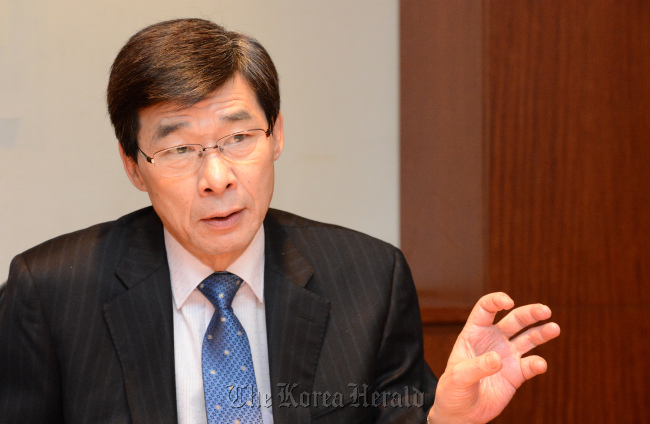Energy think tank calls for gas cooperation in Northeast Asia
In preparation for the upcoming shale gas boom, Korea needs to seek partnership with other big gas buyers in Northeast Asia, KEEI head says
By Seo Jee-yeonPublished : Feb. 12, 2013 - 20:43
Natural-resource-poor South Korea has been sensitive to changes in the global energy landscape for its energy security. One of the latest major trends in the global energy sector is the emergence of natural gas in the global energy mix, boosted by the shale gas revolution in the U.S.
In line with the trend, Korea, the world’s second-largest buyer of liquefied natural gas, is advised to develop a strategy in preparation for the “golden age of gas.”
“The upcoming shale gas boom will reduce natural gas prices and turn the global gas market into a buyers’ market. Korea needs to seek partnerships with other big gas buyers in Northeast Asia rather than compete to gain bargaining power, which will help to build a stable gas supply channel for the long term,” Kim Jin-woo, president of state-run Korea Energy Economics Institute said in an interview with The Korea Herald.
In line with the trend, Korea, the world’s second-largest buyer of liquefied natural gas, is advised to develop a strategy in preparation for the “golden age of gas.”
“The upcoming shale gas boom will reduce natural gas prices and turn the global gas market into a buyers’ market. Korea needs to seek partnerships with other big gas buyers in Northeast Asia rather than compete to gain bargaining power, which will help to build a stable gas supply channel for the long term,” Kim Jin-woo, president of state-run Korea Energy Economics Institute said in an interview with The Korea Herald.

Shale gas refers to natural gas that is trapped within shale-rock formations. The non-traditional energy source exists in several countries including the U.S., China, Canada and Australia, but only the U.S. is ready for commercialization, armed with advanced technology to draw the gas from the shale-rock formations.
“Building a gas trade hub in the region could be one possible idea for the regional energy partnership,” Kim said, in reference to Korea, Japan and China.
Market watchers, however, forecast that competition to secure shale gas, in particular, between Japan and Korea, would escalate for the time being with rising local demand for gas. Japan, the world’s largest LNG buyer, has the biggest thirst for U.S. shale gas in the region as it decided to shut down all its nuclear power plants ― which cover 30 percent of the country’s power demand ― due to rising safety concerns.
Korea also will see a rise of gas demand as a source for power, with public concerns lingering over the safety of nuclear power. It jump-started the race for U.S. shale gas last year as the state-run Korea Gas Corp. signed an agreement with a U.S. firm to purchase 3.5 million tons of natural gas a year, including shale gas, from 2017 to 2036.
The Ministry of Knowledge Economy said it would increase the share of shale gas among all natural gas imports to 20 percent by 2020.
Rise of gas in energy mix
“One of the top priorities in the nation’s energy policy is to adjust the energy supply mix, reflecting the changing energy landscape at home and abroad. As the president-elect stresses the safety of nuclear power, the new government is likely to increase the share of gas in the nation’s energy mix, which means Korea will construct more gas-fueled power plants,” said Kim, who has been involved in developing the nation’s energy policy for 30 years.
His comment also hinted that the second Basic National Energy Plan to be issued this year will not increase nuclear power plants.
In the first basic plan, issued in 2008, the share of gas in the energy mix was meant to fall to 12 percent by 2030 from 13.7 percent in 2006. The share for nuclear energy was supposed to rise to 27.8 percent by 2030 from 15.9 percent in 2006.
Regarding the deregulation of the electricity and gas markets, another key task for the nation’s energy policy, Kim said energy security has to come ahead of opening the market.
“Korea needs more stability in the energy demand and supply,” Kim said, pointing to the recent power shortage issue in peak seasons as an example.
Upgrade of energy think tank
Kim has contributed not only to developing the nation’s energy policies but also to advancing KEEI, the only think tank focusing on the energy sector, which was established in 1986.
Since his inauguration in 2010, he has reformed the institute to transform it into a globally competitive energy policy think tank.
“As an urgent task, I sought to change outdated models for research activities, while building a customer relations management system,” Kim said.
Thanks to the continued reform efforts, the KEEI was ranked 12th in a global survey of top energy and resource policy think tanks in 2012 for the first time. The University of Pennsylvania in the U.S. conducts the survey annually.
His achievements were recognized by the government as well. Kim was picked as the best leader in the government’s evaluation of leadership of state-run think tanks in 2010 and 2011.
By Seo Jee-yeon (jyseo@heraldcorp.com)



![[Exclusive] Korean military set to ban iPhones over 'security' concerns](http://res.heraldm.com/phpwas/restmb_idxmake.php?idx=644&simg=/content/image/2024/04/23/20240423050599_0.jpg&u=20240423183955)

![[Graphic News] 77% of young Koreans still financially dependent](http://res.heraldm.com/phpwas/restmb_idxmake.php?idx=644&simg=/content/image/2024/04/22/20240422050762_0.gif&u=)



![[Pressure points] Leggings in public: Fashion statement or social faux pas?](http://res.heraldm.com/phpwas/restmb_idxmake.php?idx=644&simg=/content/image/2024/04/23/20240423050669_0.jpg&u=)









